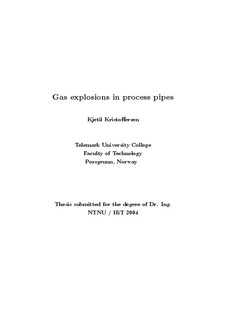| dc.contributor.author | Kristoffersen, Kjetil | |
| dc.date.accessioned | 2007-03-13T13:59:36Z | |
| dc.date.accessioned | 2017-04-19T12:10:56Z | |
| dc.date.available | 2007-03-13T13:59:36Z | |
| dc.date.available | 2017-04-19T12:10:56Z | |
| dc.date.issued | 2004 | |
| dc.identifier.isbn | 82-471-6372-1 | |
| dc.identifier.issn | 0802-3271 | |
| dc.identifier.issn | 0802-3271 | |
| dc.identifier.uri | http://hdl.handle.net/11250/2437791 | |
| dc.description | Avhandling (dr.ing.) - Høgskolen i Telemark / Norges teknisk-naturvitenskapelige universitet | |
| dc.description.abstract | In this thesis, gas explosions inside pipes are considered. Laboratory experiments and numerical simulations are the basis of the thesis. The target of the work was to study gas explosions in pipes and to develop numer- ical models that could predict accidental gas explosions inside pipes. Experiments were performed in circular steel and plexiglass pipes. The steel pipes have an inner diameter of 22.3 mm and lengths of 1, 2, 5 and 11 m. The plexiglass pipe has an inner diameter of 40 mm and a length of 1.9 m. Mixtures of propane, acetylene and hydrogen with air at various equivalence ratios were used. Pressure was recorded by Kistler pressure transducers and ame propagation was captured by photodiodes, a SLR camera and a high-speed camera. The experiments showed that acoustic oscillations would occur in the pipes, and that the frequency of these oscillations are determined by the pipe length. Several inversions of the ame front can occur during the ame propagation in a pipe. These inversions are appearing due to quenching of the ame front at the pipe wall and due to interactions of the ame front with the longitudinal pressure waves in the pipe. Transition to detonation was achieved in acetylene-air mixtures in a 5 m steel pipe with 4 small obstructions. Simulations of the ame propagation in smooth pipes were performed with an 1D MATLAB version of the Random Choice Method (RCMLAB). Methods for estimation of quasi 1D burning velocities and of pipe outlet conditions from experimental pres- sure data were implemented into this code. The simulated pressure waves and ame propagation were compared to the experimental results and there are good agreements between the results. Simulations were also performed with the commercial CFD code FLACS. The code was tested for gas explosions in smooth pipes and the results compared to experimental results. To properly handle the longitudinal pressure oscillations in pipes, at least 7 grid cells in each direction of the pipe cross-section and a Courant number (CFLC) of maximum 1 should be used. It was shown that the current combustion model in FLACS gave too high ame speeds initially for gas explosions in a pipe with an inner width of 40 mm. | |
| dc.format.extent | 5071100 bytes | |
| dc.format.mimetype | application/pdf | |
| dc.language.iso | eng | |
| dc.publisher | Telemark University College | |
| dc.relation.ispartofseries | Doctoral theses at NTNU;2004:79 | |
| dc.subject | Pipes | |
| dc.subject | Gas explosions | |
| dc.subject | Simulations | |
| dc.title | Gas explosions in process pipes | |
| dc.type | Doctoral thesis | |
| dc.type | Peer reviewed | |
| dc.rights.holder | © Copyright The Author. All rights reserved | |
| dc.subject.nsi | 562 | no |
